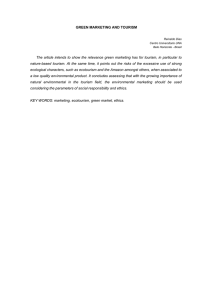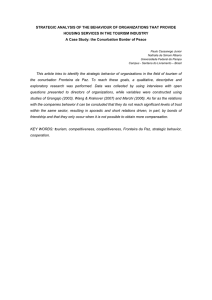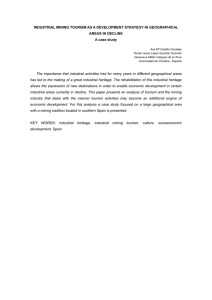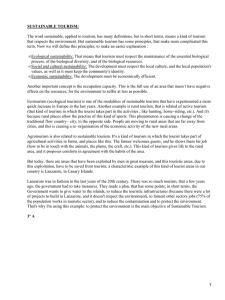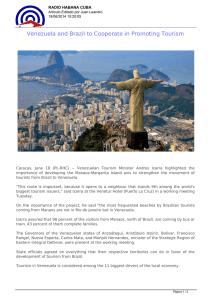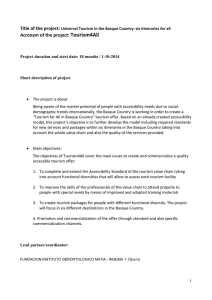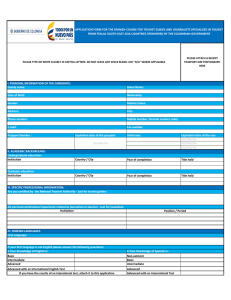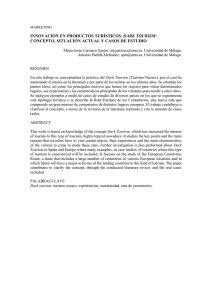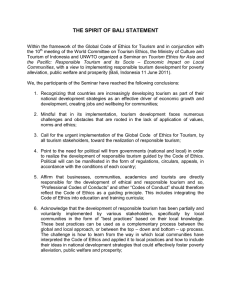External Trade, Tourism and Economic Integration in Latin America
Anuncio
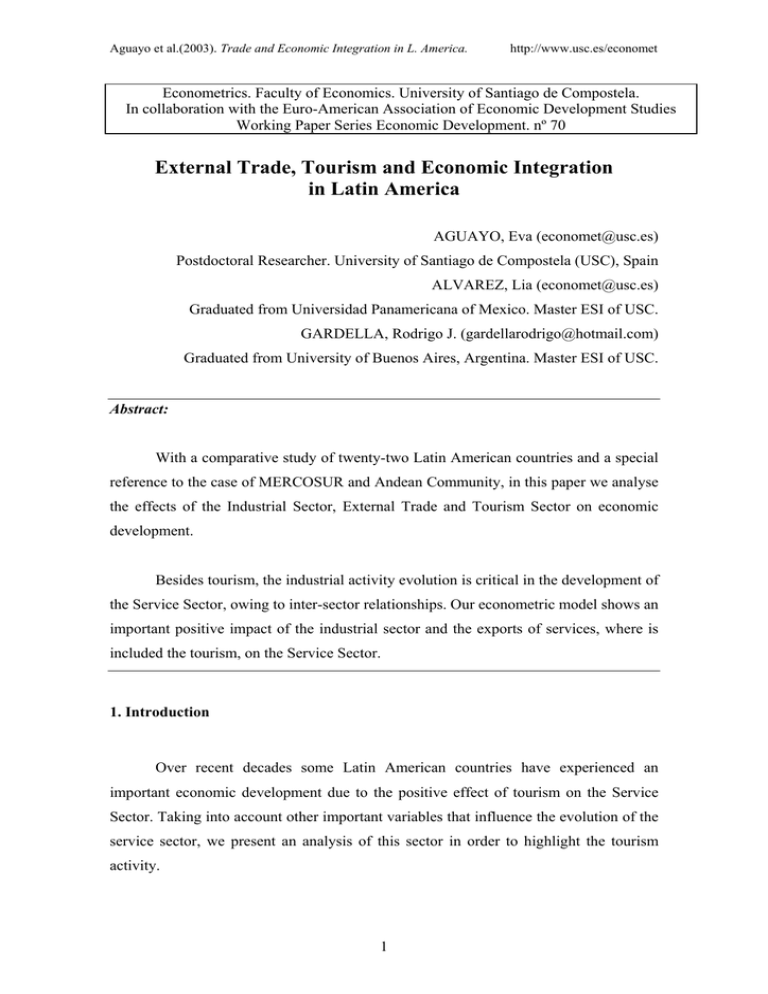
Aguayo et al.(2003). Trade and Economic Integration in L. America. http://www.usc.es/economet Econometrics. Faculty of Economics. University of Santiago de Compostela. In collaboration with the Euro-American Association of Economic Development Studies Working Paper Series Economic Development. nº 70 External Trade, Tourism and Economic Integration in Latin America AGUAYO, Eva ([email protected]) Postdoctoral Researcher. University of Santiago de Compostela (USC), Spain ALVAREZ, Lia ([email protected]) Graduated from Universidad Panamericana of Mexico. Master ESI of USC. GARDELLA, Rodrigo J. ([email protected]) Graduated from University of Buenos Aires, Argentina. Master ESI of USC. Abstract: With a comparative study of twenty-two Latin American countries and a special reference to the case of MERCOSUR and Andean Community, in this paper we analyse the effects of the Industrial Sector, External Trade and Tourism Sector on economic development. Besides tourism, the industrial activity evolution is critical in the development of the Service Sector, owing to inter-sector relationships. Our econometric model shows an important positive impact of the industrial sector and the exports of services, where is included the tourism, on the Service Sector. 1. Introduction Over recent decades some Latin American countries have experienced an important economic development due to the positive effect of tourism on the Service Sector. Taking into account other important variables that influence the evolution of the service sector, we present an analysis of this sector in order to highlight the tourism activity. 1 Aguayo et al.(2003). Trade and Economic Integration in L. America. http://www.usc.es/economet In the second section we compare the evolution of the agricultural, industrial, construction and service sectors in the Latin American countries and we consider the impact of each on their economic development. Additionally, we make particular reference to the noticeable performance of external trade during the last decade. For simplicity, we have grouped the analysed countries in three different areas of Latin America. In the third section, to highlight the importance of tourism we give a picture of the development of the service sector in twenty-two Latin American countries. In the fourth section, we present an econometric model for twenty-one Latin American countries where we correlate GDP of the service sector with the exports of services and GDP of the industrial sector. At the end of this section we present the main conclusions of this paper. 2. GDP by sectors and External Trade in Latin American countries GDP by sectors There are large differences in GDP by sectors among Latin American countries, and the majority of these differences are due to the value of industrial and service sectors. The sectoral economic activity has been increased, but in per capita terms this value decreases due to the demographic growth that Latin American countries (mainly Mexico and Brazil) had experienced during the last decades, as shows Guisan et al (1999). We assume that the increase of the educational level of the population contributes to reduce the demographic growth. 2 Aguayo et al.(2003). Trade and Economic Integration in L. America. http://www.usc.es/economet In the following three tables the GDP per capita is shown for the years 1990, 1995 and 2000 (expressed in US$95). We include the GDP for agriculture, industry, construction and the services of twenty-one Latin American countries. Table 1. Area 1. Agriculture, Industry, Construction and Services per capita (US$95). Industry Construction Ph95i ph00i ph90c ph95c Ph00c Mexicoa 1,042 892 218 188 154 Caribbean Cuba 1,050 322 425 4,529 2,064 2,688 1,360 218 355 Dominican R. 254 195 200 406 326 339 164 149 237 Haitib 142 110 81 195 90 73 80 45 48 b Jamaica 155 176 98 574 463 311 283 242 144 Central America Costa Ricac 606 412 400 952 662 784 196 142 122 c El Salvador 367 224 179 485 365 349 90 73 62 Guatemalac 481 314 294 272 182 172 47 36 32 c Honduras 154 145 105 141 134 114 39 37 27 Nicaraguac 226 146 184 128 74 78 19 15 30 Panama 256 229 222 249 270 230 36 135 151 Mean Area 1 336 245 193 1,116 856 796 266 155 145 a Is member of the North American Free Trade Agreement (NAFTA). b They are members of the Caribbean Community and Common Market. c They are members of the Central American Common Market. Source: CEPAL Country Agriculture Ph90a ph95a ph00a 263 253 164 ph90i 1,093 ph90s 3,388 Services ph95s ph00s 3,379 2,581 6,299 1,074 295 1,158 2,658 879 206 1,206 3,020 1,019 223 930 2,765 1,291 1,294 388 360 2,328 2,868 1,890 937 938 358 203 2,344 2,496 1,956 827 956 299 210 2,546 2,030 ph90s 4,553 2,783 3,232 1,184 5,327 3,104 Services ph95s 4,054 2,211 2,934 858 3,519 2,543 ph00s 4,602 2,990 3,561 898 4,209 3,253 ph90s 464 2,225 1,075 1,250 2,271 1,756 Services ph95s 454 1,373 792 1,262 1,682 1,282 ph00s 488 1,605 933 1,489 1,029 1,299 Table 2. Area 2 (MERCOSUR and Chile) Agriculture, Industry, Construction and Services per capita (US$95). East South Agriculture America Ph90a ph95a ph00a Argentina 412 338 355 Brazil 377 314 437 Chile 393 333 382 Paraguay 592 399 439 Uruguay 606 438 430 Mean Area 2 392 323 420 Source: CEPAL ph90i 1,394 1,065 1,730 397 1,918 1,161 Industry ph95i 1,207 864 1,487 257 1,013 949 ph00i 1,221 1,107 1,849 268 1,043 1,153 Construction ph90c ph95c ph00c 307 328 364 437 321 444 524 492 515 134 96 110 325 270 292 414 328 425 Table 3. Area 3 (Andean Community) Agriculture, Industry, Construction and Services per (US$95). West South Agriculture America ph90a ph95a ph00a Bolivia 144 135 129 Colombia 630 336 371 Ecuador 255 187 224 Peru 175 178 246 Venezuela 217 155 99 Mean Area 3 361 230 250 Source: CEPAL ph90i 213 805 597 418 1,145 721 Industry Ph95i 206 443 494 442 964 542 ph00i 199 500 621 535 606 522 3 Construction ph90c ph95c ph00c 25 27 26 241 180 111 116 72 93 92 146 147 158 140 81 160 140 105 Aguayo et al.(2003). Trade and Economic Integration in L. America. http://www.usc.es/economet For all areas, the GDP values per capita in the industrial and service sector were considerably higher in comparison to agriculture and construction. Therefore, the industry and the services play an important role for the economic development. During the years 1990, 1995 and 2000, Mexico, Cuba, Panama, Argentina, Brazil, Chile and Uruguay reached incomes above 2000 dollars per capita by year in the service sector. On the other hand, there are some countries like Haiti, Honduras, Nicaragua and Bolivia with incomes below 500 dollars per capita. In the three years analysed, MERCOSUR and Chile was the area with the highest means for all sectors. External Trade In terms of external trade, we evaluated the outward orientation as the ratio between total exports and GDP. We observe a noticeable evolution in Area 1 (see Graph 1), rising from 16.1% in 1990 to 32.7% in year 2000. Panama had the highest level in this area (66.5%). Mexico, Nicaragua, Jamaica and Honduras always were over the mean. In 2000, the Andean Community had a ratio of 19.8% (see Graph 2), and MERCOSUR and Chile only obtained 11.3% (see Graph 3). Colombia, Peru, Argentina and Brazil were below the mean. 4 Aguayo et al.(2003). Trade and Economic Integration in L. America. http://www.usc.es/economet Graph 1 Outward orientation in Mexico, Central America and Caribbean (ratio 1990, 1995 and 2000) 100 90 80 1990 70 1995 2000 Cr Sl 60 50 40 Mean 2000 30 Mean 1995 20 Mean 1990 10 0 Mx Cu Rd Ht Jm Gt Hn Nc Source: CEPAL Graph 2 Outward orientation in West South America (Andean Community) (ratio 1990, 1995 and 2000) 35 1990 30 1995 2000 25 Mean 2000 20 Mean1995 15 Mean 1990 10 5 0 Bo Co Ec Source: CEPAL 5 Pe Ve Pn Aguayo et al.(2003). Trade and Economic Integration in L. America. http://www.usc.es/economet Graph 3 Outward orientation in East South America (Mercosur and Chile) (ratio 1990, 1995 and 2000) 60 1990 1995 2000 50 40 30 20 Mean 2000 Mean 1995 Mean 1990 10 0 Ar Br Ch Py Ur Source: CEPAL The exports of goods and services have a general positive impact on the development of the service sector. Additionally, it is important for the development of industrial sector, as shows Guisan (2002). Besides tourism, the industrial activity evolution is critical in the development of the Service Sector, owing to inter-sector relationships. The increase of the exports of services was lower than the exports of goods, but during the last decade the importance of the service sector was enlarging. Haiti, Honduras, Cuba and Brazil have average annual growth rates upon to 7 %. In 2000, the mean of the exports of services per capita was 159 dollars in the area of Mexico, Central America and Caribbean, 56 dollars in the Andean Community and 96 dollars in MERCOSUR and Chile. 6 Aguayo et al.(2003). Trade and Economic Integration in L. America. http://www.usc.es/economet Table 4. Area 1. Exports of goods and services per capita (US$95). Total Goods Services ExpT90h ExpT95h ExpT00h ExpG90h ExpG95h ExpG00h ExpS90h ExpS95h ExpS00h Mexicoa 509 874 1,656 507 873 1,655 125 136 114 Caribbean Cuba 1,389 245 282 1,377 225 242 133 212 454 Dominican R. 144 523 762 114 491 722 214 253 337 Haitib 32 22 43 31 20 41 10 16 20 b Jamaica 714 909 611 524 669 406 452 595 529 Central America Costa Ricac 729 1,056 1,756 625 980 1,644 318 273 449 c El Salvador 234 304 528 214 291 513 102 69 93 Guatemalac 189 223 345 182 216 340 57 65 64 Hondurasc 277 267 333 271 258 324 31 49 55 c Nicaragua 88 118 175 81 111 166 25 28 46 Panama 2,245 2,535 2,199 2,028 2,315 1,969 519 577 654 Mean Area 1 522 693 1,202 508 678 1,185 130 146 159 a Is member of the North American Free Trade Agreement (NAFTA). b They are members of the Caribbean Community and Common Market. c They are members of the Central American Common Market. Source: CEPAL Country Table 5. Area 2 (MERCOSUR and Chile) Exports of goods and services per capita (US$95). Total Goods Services East South America ExpT90h ExpT95h ExpT00h ExpG90h ExpG95h ExpG00h ExpS90h ExpS95h ExpS00h Argentina 460 612 782 457 609 779 96 99 120 Brazil 250 292 377 250 291 377 31 36 67 Chile 791 1,146 1,801 774 1,128 1,782 230 259 286 Paraguay 430 897 490 392 874 468 160 112 119 Uruguay 644 788 981 568 667 870 236 389 370 Mean Area 2 329 453 631 326 416 543 61 68 96 Source: CEPAL Table 6. Area 3 (Andean Community) Exports of goods and services per capita (US$95). Total Goods Services West South America ExpT90h ExpT95h ExpT00h ExpG90h ExpG95h ExpG00h ExpS90h ExpS95h ExpS00h Bolivia 130 144 154 126 140 151 25 27 26 Colombia 240 276 297 237 275 295 86 44 56 Ecuador 247 395 360 240 390 353 74 64 89 Peru 181 236 361 179 234 358 42 47 69 Venezuela 749 877 971 746 874 969 74 70 35 Mean Area 3 326 441 550 323 395 449 67 51 56 Source: CEPAL 7 Aguayo et al.(2003). Trade and Economic Integration in L. America. http://www.usc.es/economet 3. Tourism in Latin America Since tourism stopped being a luxury activity to become a mass activity it has proved, throughout the last decades, to be a sector with steady growth. The globalisation of tourism is going to be a major phenomenon of the 21st century. More and more people are taking the chance to travel and move to a new residence for fairly long periods each year. The places that take them in have to be able to respond to their demands in terms both of quality and quantity. Table 7 shows the evolution of the International Tourist Arrivals for the six areas considered by the World Tourism Organization (WTO). For all areas, we observe a sustained growth during the period 1990-2000. Table 7. Growth rates of International Tourism Income and International Tourist Arrivals. International Tourism Income International Tourist Arrivals (US$ billion) (million) 1990 2000 Growth Rate 1990 2000 Growth Rate 5,3 10,8 104% 15 27,2 81% Africa 69,2 132,8 92% 92,9 128,5 38% Americas 82 109% 54,6 109,3 100% East Asia and the Pacific 39,2 143,2 234,5 64% 282,7 402,5 42% Europe 4,4 12,2 177% 9 23,2 158% Middle East 2 4,7 135% 3,2 6,1 91% South Asia 263,4 477 81% 457,3 696,8 52% World Source: WTO In the same period, the areas that experienced the most noticeable evolution for International Tourist Arrivals, representing more than 80% growth, were Middle East, East Asia and the Pacific (China, Japan, Malaysia and Thailand among others), South Asia (India, Bangladesh and Maldives among others) and Africa (mainly East and Southern Africa). 8 Aguayo et al.(2003). Trade and Economic Integration in L. America. http://www.usc.es/economet Income due to International Tourism has had also a positive performance during the period 1990-2000 for all areas. It is worth highlighting the evolution of the Americas, which achieved a substantial increase of International Tourism Income despite being the area with the smallest increase in International Tourist Arrivals. In this region the expenditure per capita (i.e. per tourist) has increased, a fact that can be regarded as an increment in the “quality of tourism”. Graphic 4 shows the market share of International Tourist Arrivals for each area. Europe, despite losing some market share, still holds the lead. Similar shrinking behaviour, in terms of market share, is also seen in the Americas. This performance suggests a trend to prefer exotic and new places instead of traditional destinations. Graph 4. Percentage of International Tourist Arrivals (1990-95-2000). 2000 1995 1990 0% Africa 20% Americas 40% 60% East Asia and the Pacific Source: WTO 9 Europe 80% Middle East 100% South Asia Aguayo et al.(2003). Trade and Economic Integration in L. America. http://www.usc.es/economet Graph 5. Percentage of International Tourism Income (1990-95-2000). 2000 1995 1990 0% Africa 20% Americas 40% 60% East Asia and the Pacific Europe 80% Middle East 100% South Asia Source: WTO Graphic 5 shows that the Americas and Middle East have improved their share of International Tourism Income at the time that Europe and East Asia and the Pacific have lost market share. Again, we emphasise the performance of the Americas, showing the strongest growth of the Tourism Sector (measured by income) across all the areas. Next, we analyse the evolution of tourism in the Latin America countries during the years 1990, 1995 and 2000, but before going into the analysis, we would like to make a remark about Mexico. This country had high level of tourism activity at the beginning of the period. Throughout the rest of the decade, its experienced an important growth in tourism activity, which still keeps its position within the top ten tourist destinations in the world. 10 Aguayo et al.(2003). Trade and Economic Integration in L. America. http://www.usc.es/economet In Table 8 we see a strong contrast in tourism between the countries in the Caribbean (Cuba, Dominican Republic, Haiti, Jamaica and Puerto Rico) and those in Central America (Costa Rica, El Salvador, Guatemala, Honduras, Nicaragua and Panama). While the majority of the countries in the Caribbean experienced considerable increments in tourism activity, those in Central America (except Costa Rica) had low levels of tourism activity, despite experiencing a growing trend in the period. We think that Central America as a region should adopt a common tourism policy built upon an adequate infrastructure offering and promotion of its archaeological and historic tourism. This common policy should aim at positioning Central America as a competitive option against the Caribbean Zone. Table 8. Area 1 International Tourism Income and International Tourist Arrivals (1990-95-2000). Méxicoa International Tourism Income International Tourist Arrivals US$ millon thousand 1990 1995 2000 1990 1995 2000 5467 6179 8295 17176 20241 20641 Caribbean Cuba 243 977 1737 327 361 1741 Dominican Rep. 900 1568 2860 1305 1776 2973 46 56 54 144 145 140 740 1069 1333 989 1147 1323 1366 1828 2388 2560 3131 3341 b Haití Jamaica b Puerto Rico Central America Costa Rica c El Salvadorc c 660 1229 435 785 1088 18 41 254 194 235 795 185 277 535 509 563 826 c 29 107 262 290 271 471 c 12 50 111 106 281 486 172 367 576 214 345 484 Guatemala Honduras Nicaragua Panama 275 a Is member of the North American Free Trade Agreement (NAFTA). They are members of the Caribbean Community and Common Market. c They are members of the Central American Common Market. Source: WTO b 11 Aguayo et al.(2003). Trade and Economic Integration in L. America. http://www.usc.es/economet Table 9 emphasises the strong growth experienced by Brazil during the decade, as show Gardella and Aguayo (2002). Chile is an atypical case because the evolution of its tourism activity shows that, although the number of International Tourist Arrivals increased, the International Tourism Income started to decrease by the end of the decade, possibly indicating a shrinking trend in the expenditure carried out by international tourists. Table 9. Area 2 (MERCOSUR and Chile) International Tourism Income and International Tourist Arrivals (1990-95-2000). International Tourism Income International Tourist Arrivals US$ millon thousand East South America 1990 1995 2000 1990 1995 2000 Argentina 1131 2144 2817 1930 2289 2991 Brazil 1444 2097 4228 1091 1991 5131 Chile 540 900 827 943 1540 1742 Paraguay 128 137 101 280 438 221 Uruguay 238 611 652 1267 2177 2236 Source: WTO Table 10. Area 3 (Andean Community) International Tourism Income and International Tourist Arrivals (1990-95-2000). West South International Tourism Income International Tourist Arrivals US$ millon thousand America 1990 1995 2000 1990 1995 2000 Bolivia 91 139 160 217 351 381 Colombia 406 657 1028 813 1399 557 Ecuador 188 255 402 362 494 615 Peru 217 428 911 317 541 1027 Venezuela 496 951 563 525 597 469 Source: WTO, CAN and PROMPERU 12 Aguayo et al.(2003). Trade and Economic Integration in L. America. http://www.usc.es/economet Table 10 shows a noticeable growth of the tourism activity in Peru and Ecuador, as in Gardella and Aguayo (2003). It is also worth noting the case of Colombia, where the International Tourist Arrivals decreased abruptly at the end of the period without carrying a loss of International Tourism Income and even taking it to levels well above those of 1995. The case of Colombia shows the opposite situation to that of Chile. Graph 6 shows the International Tourism Income for twenty-two Latin America countries in the year 2000. A significant difference between Mexico and the other countries of the region can be observed. Besides Mexico, only five countries were above the mean (1.42 $ billion): Cuba, Dominican Republic, Puerto Rico, Argentina and Brazil. Graph. 6. International Tourism Income of Latin America (year 2000). 10000 MX 8000 n oi ll i m $ S U 6000 BR 4000 DR CU 2000 JM 2 4 MEAN CR CO PN GT ES HN NC HT 0 AR PR 6 8 10 12 CH 14 UR PY B O 16 18 PE EC VE 20 22 Source: WTO In 2000 the International Tourism Income of Haiti, Nicaragua, Paraguay and Bolivia altogether barely accounted for 30% of the mean of the Latin America region, showing the lack of development of the Tourism Sector in such countries. 13 Aguayo et al.(2003). Trade and Economic Integration in L. America. http://www.usc.es/economet During the period 1990-2000, Haiti, Paraguay and Venezuela were the only countries of those analysed in this report to experience a shrinking behaviour in both International Tourist Arrivals and International Tourism Income. We can appreciate the case of Spain, which is one of the leaders of international tourism. In this country, the number of tourists coming every year has currently swollen to more than 50 million, although the country has less than 40 million inhabitants. Spain`s success is evidently due to a series of natural characteristics, but is also the result of investment and effort over the last few years. A key role has been played not only by the Central Administration, but also by the country´s various regional authorities. All of them are doing their utmost to boost their offer, modernwise their facilities and publicise their attractions. The Latin American countries have optimal natural characteristics for tourism, but is necessary to adopt a responsible initiative in order to develop these benefits. We consider that the ongoing economic integration developments in Latin America such as Caribbean Community and Common Market, Central American Common Market, Andean Community and MERCOSUR offer an important opportunity to further develop the tourism sector in the region through a conjoint policy that takes into consideration the importance of the Tourism Sector for the economic growth. 4. Econometric Model The specification of the model follows the form of a mixed dynamic model, where PIBS95 is the explained variable; and the explanatory variables are: their lagged value in levels (PIBS95(-1)); the increment of the GDP of industrial sector (DPIBI95), and the increment of the exports of services (DXS95). This model is based on the specification suggested by Guisan et al (2002) at world level. 14 Aguayo et al.(2003). Trade and Economic Integration in L. America. http://www.usc.es/economet The model variables are: PIBS95 = GDP of Service sector. D(XS95) = First difference of the increment of exports of services. D(PIBI95) = First difference of the increment of GDP of industrial sector. Dependent Variable: PIBS?95 Method: Pooled Least Squares Sample(adjusted): 1991 2000 Included observations: 10 after adjusting endpoints Total panel observations 210 Variable Coefficient Std. Error t-Statistic Prob. PIBS?95(-1) D(XS?95) D(PIBI?95) 0.997623 1.996680 2.761722 0.002519 0.775160 0.060401 395.9735 2.575829 45.72332 0.0000 0.0107 0.0000 R-squared Adjusted R-squared S.E. of regression Log likelihood Durbin-Watson stat 0.998559 0.998545 4037.015 428.2970 2.016666 Mean dependent var S.D. dependent var Sum squared resid F-statistic Prob(F-statistic) 54355.72 105821.8 3.37E+09 71700.03 0.000000 The table above presents the estimation of our model for twenty-one American countries. The results show an important positive impact of the industrial sector and the exports of services, where is include the tourism, on the Service Sector. The model provides a high goodness of fit. 5. Conclusions As we show in this paper, if Latin American countries adopted economic policies encouraging investment efforts coupled with the development of international trade strategies they could achieve a significant economic development for the service sector in the next years. 15 Aguayo et al.(2003). Trade and Economic Integration in L. America. http://www.usc.es/economet Development policies should have priority over adjustment policies. The economic development, in per capita terms, has been weak for the majority of the countries in Latin America, in some cases due to an excessive demographic growth (like Mexico and Brazil) and in some others due to a limited growth or stagnation of the total output. Demographic moderation and industrialization are two important elements for economic growth, and both variables depend on the educational development. The agricultural sector shows a strong level of output per capita in the majority of the Latin American countries when compared to other countries and to the world average. However, the potential for expansion in this sector is rather limited. We think that the industrial development is the main driver of economic development and is fundamental to foster growth in other economic sectors such as construction and services. We consider that the ongoing economic integration developments in Latin America such as Caribbean Community and Common Market, Central American Common Market, Andean Community and MERCOSUR offer an opportunity to further develop the tourism sector in the region through a conjoint policy which takes into consideration the importance of the tourism sector to economic growth. Such economic integration developments consider the expansion of the service sector through developing regional infrastructure projects and recognising the importance of the tourism sector. There are opportunities for further development in the industrial and tourism sectors in Latin America. Considering the positive consequences that industrial and tourism activity increments have on the development of private and public services, Latin America countries should adopt policies to improve their ability to profit from such opportunities. 16 Aguayo et al.(2003). Trade and Economic Integration in L. America. http://www.usc.es/economet Bibliography Aguayo, E.; Guisan, M. C. and Rodriguez, X.A.(2001). “Impacto de la industria y el turismo sobre el crecimiento económico de las regiones españolas”. Estudios Económicos Regionales y Sectoriales. Vol. 1-1, pp. 67-79. 1 Aguayo, E; Lamelas, N. and Exposito, P.(2001). “Econometric Model of Services and Impact of Tourism in Latin American Countries”. Applied Econometrics and International Development. Vol. 2-1, pp. 43-58. 1 Aquino, C.A.(1997). “Experiencias de procesos de integración económica: el Pacto Andino, la Unión Europea y el ASEAN”. Revista de la Facultad de Ciencias Económicas de la Universidad Nacional de San Marcos, nº 4. Lima. Banco Interamericano de Desarrollo(1997). “Progreso económico en América Latina tras una década de reformas”. CEPAL(1998). “Balance preliminar de la economía de América Latina y del Caribe”. CEPAL(several years). “Anuario estadístico de América Latina y Caribe”. Chacaltana, J.(1999). “El Turismo en el Perú: Perspectivas de crecimiento y generación de empleo”. Organización Internacional del Trabajo. Figuerola, M.(2000). “Introducción al estudio económico del turismo”. Civitas Ediciones, Madrid Figuerola, M.(1990). “Teoría Económica del Turismo”. Alianza Universidad Textos, Madrid Fondo Monetario Internacional(1998). “Estadísticas financieras internacionales”. 17 Aguayo et al.(2003). Trade and Economic Integration in L. America. http://www.usc.es/economet Gardella, R. and Aguayo, E.(2002). “Impacto económico del turismo en el MERCOSUR y Chile (1990-2000)”. Estudios Económicos de Desarrollo Internacional. Vol. 2-1. pp. 27-50. 1 Gardella, R. and Aguayo, E.(2003). “Análisis econométrico de la demanda turística internacional en la CAN”. XVII Reunion Asepelt-España. Almeria, June. De Gregorio, J.(1992). “El crecimiento económico en la América Latina”. Trimestre Económico. Vol. LIX, especial issue. México. Guisan M. C.(1997). “Econometría”. Mc Graw Hill, Madrid. Guisan, M.C. and Aguayo, E.(2002). “Education, Industry, Trade and Development of American countries in 1980-99”. Applied Econometrics and International Development. Vol. 2-1, pp. 83-106. 1 Guisan, M.C.; Cis, K. and Neira, S.(1999). “Relaciones internacionales de Centroamérica y procesos de integración económica”. Working paper nº 38 of Economic Development. 1 Guisan, M.C.; Aguayo, E. and Exposito, P.(2002). “Relaciones intersectoriales en Latinoamérica en el período 1980-99: un análisis econométrico”. Estudios Económicos de Desarrollo Internacional. Vol. 2-1, pp. 7-26. 1 Guisan, M.C.; Cancelo, M.T., Aguayo, E. and Diaz, R.(2001). “Modelos econométricos interregionales de crecimiento de la industria y los servicios en las regiones europeas 1985-95”. Estudios Económicos, nº 5, of AHG. Distribution: Mundi-Prensa, Madrid. 1 Guisan, M.C.; Cancelo, M.T.; Neira, I.; Aguayo, E. and Exposito, P.(2001). “Crecimiento económico en los países de la OCDE 1. Modelos de crecimiento y empleo en Irlanda, Francia, España, Alemania, USA y Japón”. Estudios Económicos, nº 4, of AHG. Distribution: Mundi-Prensa, Madrid. 1 18 Aguayo et al.(2003). Trade and Economic Integration in L. America. http://www.usc.es/economet Guisan, M.C.; Neira, I. and Aguayo, E.(2001). “Turismo Regional en Europa. Perspectiva general y modelización econométrica de las regiones españolas”. Working paper nº 51 of Economic Development. 1 Jud, G.D. and Joseph H.(1974). “International Demand for Latin American Tourism”. Growth and Change, pp. 25-31. Ledesma, F.; Navarro, M. and Perez, J.(1999). “Panel data and tourism demand. The case of Tenerife”. Working paper nº 99-17. Fundación de Estudios de Economía Aplicada (FEDEA). Porto, N.(1999). “El turismo como alternativa de crecimiento”. Económica, nº 4. Pulido, A.(1966). “Introducción al análisis econométrico del Turismo”. Instituto de Estudios turísticos. Rabahy, W.(1992). “Modelo de Predicción en Turismo: un Proyecto Experimental en Brasil”. Estudios y Perspectivas en Turismo. Vol. 3, pp. 198-215. Rey, C.(1998). “Economía del Turismo. Estructura de mercados e impacto sobre el desarrollo”. Estudios Económicos, nº 1, of AHG. Distribution: Mundi-Prensa, Madrid. 1 Robano, V.(2000). “Determinantes del Turismo Receptivo en Uruguay”. Working paper of Central Bank of Uruguay. WTO(2001). “Statistics Yearbook”. World Tourism Organization. WTO(2001). “Tourism Market Trends: America”. World Tourism Organization. WTO(2002). “Tourism Highlights”. World Tourism Organization. 1 Information about these documents is available at www.usc.es/economet 19
